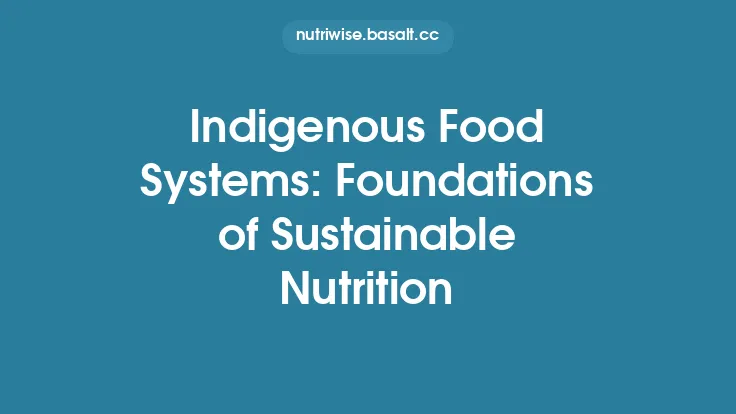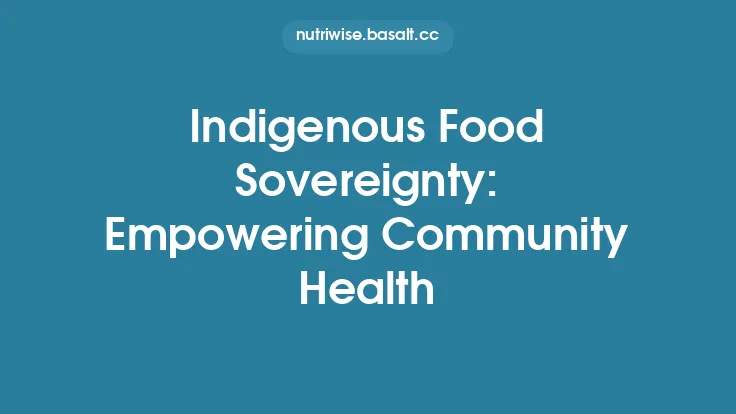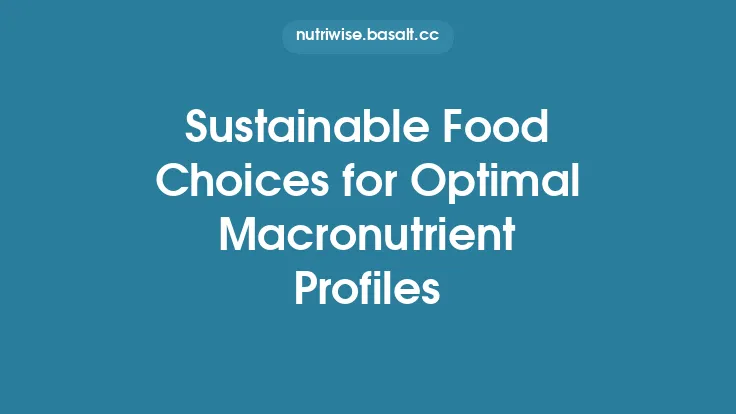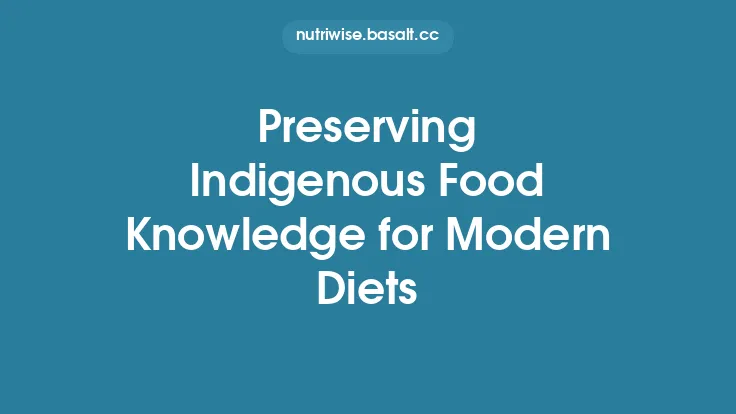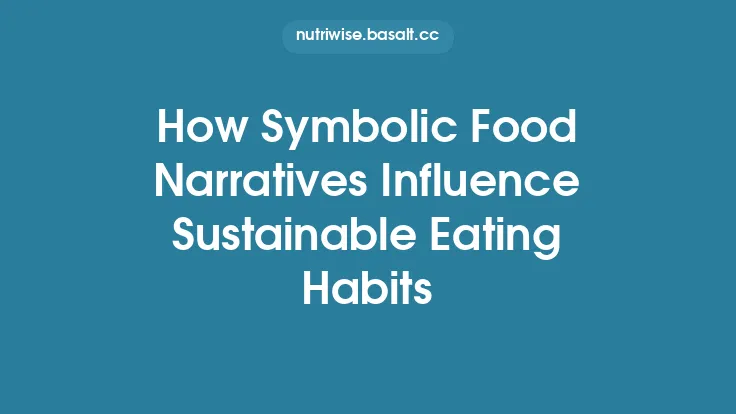Indigenous food resources are far more than mere ingredients; they embody centuries‑old relationships between people, land, and the spiritual world. When non‑Indigenous individuals, organizations, or businesses seek to incorporate these foods into their own practices—whether for culinary innovation, research, or commercial development—it is essential to proceed with humility, transparency, and respect. The following guidelines provide a comprehensive framework for engaging with Indigenous food resources responsibly, ensuring that cultural integrity, community well‑being, and ecological balance are upheld.
Understanding Cultural Context
- Historical Background
- Recognize that many Indigenous food systems were disrupted by colonization, forced relocation, and policy‑driven assimilation. This history shapes contemporary attitudes toward sharing and using traditional foods.
- Acknowledge that food is often tied to ceremonies, rites of passage, and seasonal cycles that hold deep spiritual significance.
- Cultural Significance of Specific Foods
- Some plants, animals, or preparation methods may be sacred, restricted to certain gender roles, or reserved for specific community members.
- Conduct preliminary research (through reputable academic sources, community publications, or cultural liaison officers) to identify any such restrictions before any direct engagement.
- Language and Terminology
- Use the community’s preferred names for foods and practices. Avoid generic or colonial labels that erase Indigenous identities.
- When possible, incorporate Indigenous language terms alongside English translations, showing respect for linguistic heritage.
Engaging with Indigenous Communities
- Identify the Appropriate Community Representatives
- Determine which nation, tribe, or clan holds stewardship over the food resource in question.
- Reach out to recognized governing bodies, cultural councils, or elders rather than assuming a single “voice” represents the entire community.
- Build Long‑Term Relationships
- Prioritize ongoing dialogue over one‑off transactions. Trust is cultivated through consistent, respectful interaction.
- Attend community events, cultural gatherings, or public meetings (when invited) to demonstrate genuine interest beyond the immediate project.
- Transparent Communication
- Clearly articulate the purpose of your interest, the intended use of the food resource, and any potential outcomes (e.g., product development, academic publication, marketing).
- Provide opportunities for community members to ask questions, voice concerns, and suggest modifications.
Obtaining Free, Prior, and Informed Consent (FPIC)
- Free – Consent must be given voluntarily, without coercion, intimidation, or undue influence.
- Prior – The community should have sufficient time to consider the proposal before any agreement is reached.
- Informed – All relevant information—including potential risks, benefits, and alternatives—must be shared in an understandable format.
- Consent – Explicit agreement must be documented, preferably in writing, and should be revisited if project parameters change.
*Practical Steps*
- Draft a consent document in plain language, and where possible, provide translations into the community’s language.
- Include clauses that allow the community to withdraw consent at any stage without penalty.
- Record meetings (with permission) to maintain an accurate account of discussions.
Respecting Traditional Knowledge and Intellectual Property
- Recognition of Knowledge Holders
- Attribute any traditional knowledge (TK) to the specific individuals, families, or groups who originated it.
- Avoid generic statements such as “Indigenous knowledge says…”.
- Intellectual Property (IP) Safeguards
- Explore mechanisms such as Traditional Knowledge (TK) licenses, community‑owned patents, or benefit‑sharing agreements that protect the community’s IP rights.
- Refrain from filing patents on a food resource or processing method without explicit community approval and negotiated terms.
- Data Sovereignty
- If research involves collecting data (e.g., ethnobotanical surveys, oral histories), store the data in a manner that respects the community’s control over its own information.
- Offer the community access to all raw data and final outputs, and allow them to dictate how the data may be shared externally.
Sustainable Harvesting Practices Aligned with Cultural Norms
- Ecological Stewardship
- Follow the community’s traditional harvesting calendars, which often align with ecological cues (e.g., moon phases, animal migrations).
- Adopt “take only what is needed” principles, ensuring that extraction does not exceed regeneration rates.
- Harvesting Techniques
- Use tools and methods prescribed by the community, which may be designed to minimize damage to the plant or animal and to preserve the surrounding habitat.
- When introducing new tools, seek community approval and training to avoid unintended ecological impacts.
- Monitoring and Adaptive Management
- Establish joint monitoring protocols with community members to track the health of the resource population.
- Be prepared to adjust harvesting intensity or timing based on observed changes, respecting the community’s adaptive management strategies.
Benefit‑Sharing and Economic Reciprocity
- Equitable Financial Arrangements
- Develop revenue‑sharing models that reflect the value contributed by the community’s knowledge and resources.
- Consider upfront payments, royalty structures, or profit‑sharing agreements that are transparent and auditable.
- Non‑Monetary Benefits
- Support community capacity building (e.g., training in food safety, business development, or scientific methods).
- Contribute to community‑identified priorities such as health programs, education scholarships, or infrastructure projects.
- Community‑Led Product Development
- Whenever feasible, allow the community to retain control over branding, marketing, and distribution of any product derived from their food resources.
- This approach safeguards cultural integrity and ensures that benefits remain within the community.
Legal and Policy Frameworks
- National and International Laws
- Familiarize yourself with relevant legislation, such as the United Nations Declaration on the Rights of Indigenous Peoples (UNDRIP), the Convention on Biological Diversity (CBD), and any country‑specific Indigenous rights statutes.
- Ensure compliance with regulations governing the collection, transport, and commercialization of biological resources.
- Indigenous Governance Structures
- Respect the community’s own legal frameworks, bylaws, and decision‑making processes.
- Obtain any required permits or approvals from tribal councils, land trusts, or cultural heritage boards before proceeding.
- Liability and Risk Management
- Draft contracts that clearly delineate responsibilities, indemnities, and dispute‑resolution mechanisms, preferably incorporating culturally appropriate mediation processes.
Education and Capacity Building
- Cultural Competency Training
- Provide staff and partners with training on Indigenous histories, cultural protocols, and respectful communication.
- Include modules on the significance of food within Indigenous worldviews.
- Knowledge Exchange Programs
- Facilitate reciprocal learning opportunities, such as community workshops where Indigenous chefs teach traditional preparation methods, while external experts share food safety or marketing insights.
- Documentation and Archiving
- Co‑create educational materials (e.g., recipe books, multimedia guides) that are approved by the community and can be used for intergenerational transmission of knowledge.
Monitoring, Evaluation, and Adaptive Management
- Joint Indicators
- Develop evaluation metrics in partnership with the community, covering ecological health, cultural satisfaction, and economic outcomes.
- Use both quantitative data (e.g., harvest yields) and qualitative feedback (e.g., community narratives).
- Regular Review Meetings
- Schedule periodic check‑ins to discuss progress, address concerns, and adjust practices as needed.
- Ensure that community representatives have equal voice in decision‑making during these reviews.
- Transparent Reporting
- Produce reports that are accessible to the community (e.g., in plain language, translated versions) and publicly share findings where appropriate, respecting any confidentiality agreements.
Illustrative Case Studies (Brief Overviews)
| Community | Food Resource | Respectful Practice Implemented | Outcome |
|---|---|---|---|
| Navajo Nation | *Churro* (a traditional wild grain) | FPIC obtained; harvest limited to 30 % of annual yield; royalties directed to tribal education fund | Sustainable harvest maintained; increased funding for local schools |
| Māori iwi (New Zealand) | *Kawakawa* (native shrub) | Co‑development of a community‑owned brand; traditional preparation methods protected under a TK license | Product entered national market; iwi retained control over branding and profit distribution |
| Sámi people (Northern Europe) | *Reindeer‑herded berries* | Harvest calendar aligned with reindeer migration; community members trained in modern packaging while preserving traditional handling | Extended shelf‑life without compromising cultural protocols; income shared with herding families |
These snapshots demonstrate how the guidelines translate into concrete actions that honor cultural values while delivering tangible benefits.
Concluding Thoughts
Respectful use of Indigenous food resources is not a checklist to be completed once and forgotten; it is an ongoing commitment to partnership, humility, and reciprocity. By grounding every step—research, harvesting, processing, and commercialization—in the cultural, ecological, and legal frameworks of the Indigenous communities involved, we safeguard both the integrity of the food systems and the rights of the peoples who have nurtured them for generations. Adhering to these guidelines ensures that the rich culinary heritage embedded in Indigenous foods can be shared responsibly, enriching broader societies while honoring the stewards of the land.
